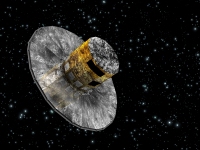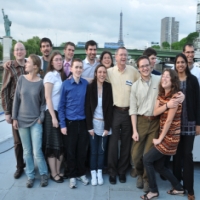Scientific community makes GREAT progress towards Gaia
29 June 2010
With the launch of Gaia only two years away, the European science community is actively engaged in training the next generation of young astronomers who will exploit the flood of data from this 'Cornerstone' science mission.In many ways, Gaia is a follow-on to ESA's groundbreaking Hipparcos satellite, which mapped the sky between 1989 and 1993. Hipparcos was the first space mission designed for astrometry – the precise measurement of the positions, distances and proper motions of stars.
 |
|
The Gaia spacecraft. Credit: ESA |
"Hipparcos could detect stars to the 12th magnitude, whereas Gaia will go down to 20th magnitude," explained Timo Prusti, ESA Project Scientist for Gaia. "Hipparcos measured the positions of almost
Various initiatives are already under way to ensure that the European scientific community is ready to handle and analyse this deluge of data. More than 400 scientists from many different countries have been selected by ESA for the Gaia Data Processing and Analysis Consortium (DPAC) in order to prepare for the extremely challenging task of processing all of the data, with the eventual creation of an all-sky catalogue.
 |
|
Some of the ELSA Fellows with Lennart Lindegren, the scientific coordinator for ELSA. Image courtesy of Stefan Jordan. |
Projects undertaken by the ELSA fellows have included development of improved models of stars, their spectra and spatial distributions, and methods to solve the complex mathematical equations required to determine their positions.
Another important contribution has involved modelling the effects of long-term exposure to particle radiation on Gaia's detectors.
"This was not originally seen as part of the preparations for Gaia, but it has been very valuable," said Lennart Lindegren of Lund Observatory, Sweden, the scientific coordinator for ELSA. "Gaia will be placed in an orbit at the L2 Lagrange Point, 1.5 million kilometres from Earth, where it will be fully exposed to charged particles from the Sun. This will cause a gradual deterioration of the CCDs over the 5-year mission, but the work done under ELSA will hopefully make it possible to eliminate most of the effects."
As ELSA draws to a close, another community-based initiative, known as the Gaia Research for European Astronomy Training (GREAT) project, is getting under way. Although everyone in ELSA is also involved in GREAT, the two projects are very different.
"ELSA has helped to prepare for the creation of the Gaia catalogue," said Lennart Lindegren, "while GREAT will prepare the community to use the data once it has been produced."
Over 550 researchers from 17 European countries and ESA will be participating in the network, which is organised by the Gaia Science Team and the Data Processing and Analysis Consortium Executive (DPACE).
"GREAT will cover all of the areas of scientific study covered by Gaia," said Nicholas Walton, chairman of the GREAT network and a researcher at the Institute of Astronomy, University of Cambridge, UK. "Its overall objective is to support a science-oriented network which will address the scientific issues in which Gaia will have a major impact."
"Initial funding for five years to cover attendance at conferences and workshops, and visits to other institutions, has been provided by the European Science Foundation. These will help to bring the Gaia community together and enable scientists to share their expertise and ideas," he added.
Since Gaia will detect large numbers of supernovas, microlensing events, novas, gamma ray burst afterglows, and other interesting transient or anomalous phenomena, the most recent workshop involved discussions about the impact that Gaia will have on studies of these objects and the importance of follow-up observations by ground-based instruments. A previous meeting looked at the ways in which Gaia will revolutionise studies of star formation and the evolution of open star clusters. Five more GREAT workshops and conferences are being organised for the coming year.
Discussions with the European Union concerning funding under the Seventh Framework Programme (FP7) for 17 Early Stage Researchers are currently in progress, and it is hoped that this Initial Training Network will be able to start in early 2011.


